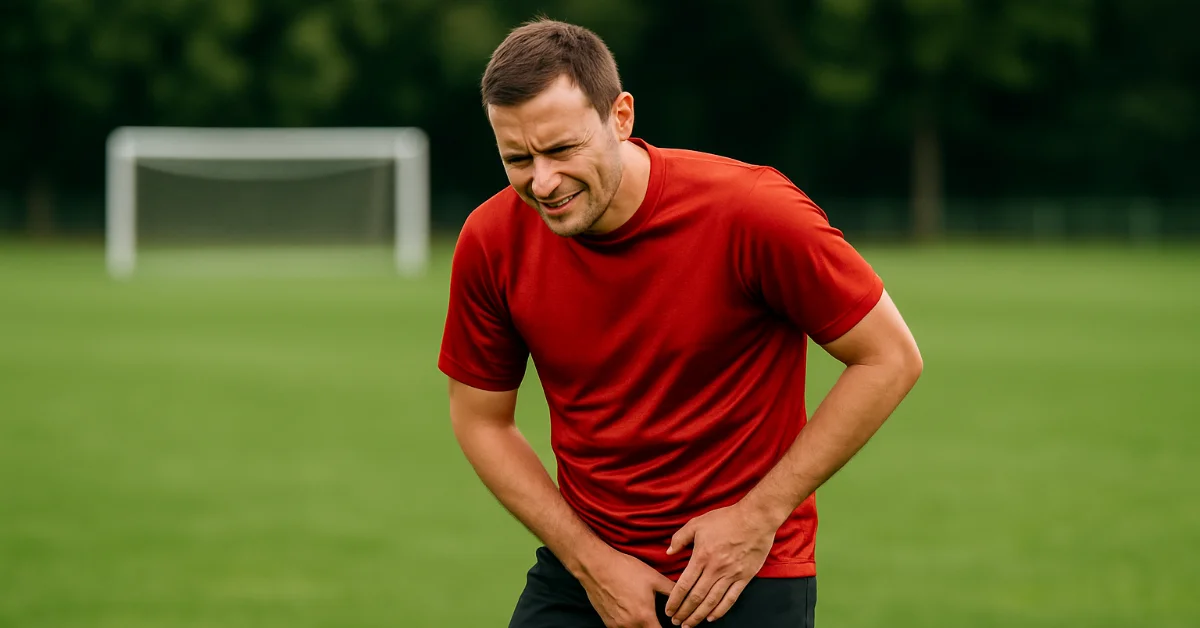
A sports hernia is a painful soft tissue injury in the lower abdomen or groin caused by repetitive twisting, turning, or explosive movements. Despite its name, it is not a true hernia, but if left untreated, it can develop into one. This condition is especially common in athletes but can affect anyone who performs sudden or strenuous physical activity.
Quick Facts About Sports Hernias
- Other Names: Athletic pubalgia, Gilmore’s groin, incipient hernia
- Most Common In: Male athletes (football, hockey, soccer)
- Key Symptom: Persistent groin pain that returns with activity
- Treatment: Rest, physical therapy, or surgery for severe cases
What Is a Sports Hernia?
A sports hernia occurs when soft tissues (muscles, tendons, or ligaments) in the lower abdomen or groin are torn or overstretched.
Why It’s Different from a Traditional Hernia
- Sports hernia: No visible bulge, pain is activity-related.
- True hernia (e.g., inguinal): Protrusion of tissue or organs through abdominal wall with a noticeable bulge.
Causes and Risk Factors
Sports hernias are caused by sudden twisting or repetitive stress in the lower abdomen and pelvis.
Common Causes
- Sudden directional changes (football, soccer, hockey)
- Overuse injuries in high-intensity training
- Repeated kicking or sprinting
- Core muscle weakness or imbalance
Who Is at Risk?
- Male athletes under 40 (3–15% of cases are female)
- Elite athletes (football, soccer, hockey players)
- Active adults performing explosive or twisting movements
H2: Symptoms of a Sports Hernia
- Sharp pain in the groin during activity
- Pain that improves with rest but returns with sports
- No visible bulge (unlike traditional hernias)
- Stiffness or weakness in the lower abdomen or groin
- In severe cases: inability to continue sports without pain
Untreated sports hernias can sometimes progress into an inguinal hernia with a visible bulge.
Diagnosing a Sports Hernia
Sports hernias are harder to diagnose because they don’t show a bulge.
Physical Exam
Your doctor will examine the groin, test muscle strength, and ask you to cough, strain, or move to see how symptoms change.
Imaging Tests
- MRI: Best for visualizing soft tissue tears
- Ultrasound: Can detect movement of tissues in real time
- CT Scan: Sometimes used to rule out bone injuries
Treatment Options for Sports Hernia
Nonsurgical Treatments
- Rest & ice (first 1–2 weeks)
- Physical therapy to strengthen core and hip muscles
- NSAIDs (ibuprofen, naproxen) to reduce pain and inflammation
- Gradual return to activity after 4–6 weeks of PT
Surgical Treatments
For severe or recurrent cases:
- Open repair surgery: Incision in the groin to repair tissue with sutures or mesh (6–8 week recovery).
- Laparoscopic repair: Minimally invasive, faster recovery, smaller scars.
- Adductor tenotomy: If groin tendons are severely damaged and causing chronic pain.
Recovery and Return to Sports
- 4–6 weeks: Most athletes return with PT if no surgery required.
- 6–8 weeks: Typical recovery after surgery.
- A structured rehabilitation program is key to safe return to play.
Complications if Left Untreated
- Chronic groin pain
- Reduced athletic performance
- Risk of developing a true inguinal hernia
- Prolonged time away from sports
Preventing Sports Hernias
- Strengthen core and hip muscles
- Warm up before high-intensity activity
- Avoid overtraining and fatigue
- Use proper technique in explosive sports movements
When to See a Doctor
See a doctor if:
- You have persistent groin pain despite rest
- Pain returns every time you resume activity
- Pain interferes with daily activities or sleep
Expert Care at Hernia Innovations
At Hernia Innovations, we specialize in diagnosing and treating sports hernias with both conservative and surgical options. Whether you’re a professional athlete or simply want to get back to daily activity, our team can help.
Call us today at (925) 940-1025 or Book a Consultation Online to take the first step toward recovery.






